What really struck me when I arrived on Tristan da Cunha is not that is it strange place, but rather that it is not. I flew to the furthest part of Africa from North America and sailed for 10 days to an island in the middle of the ocean. If I had discovered some exotic Bronze Age tribal settlement it would have been less surprising than what I did find: a perfectly normal little British village. Of course, when I stepped off the transfer boat and the Secretary to the Island’s Administrator said: “You must be Colin!”, I knew I was not in just another British village. She introduced me to a couple around my age who would be my hosts, as there is no hotel on Tristan. Actually, she introduced me to the wife, as the husband was part of the crew offloading the ship. We walked to the house and my suitcase was delivered later.
Soon after, my host Debbie was working on this bagful of crawfish. I had booked a home stay including all meals, as there isn’t really a restaurant on the Island. A cafe serves a few things, but only for limited hours. However, there are a few available apartments or in-law suites available for booking.
Since he though he was going to work strange hours, the journalist chose a self-catering option. Talking to him, I discovered a little secret. If you book a home stay, your hosts will cook for you. If you book a self-catering option (at half the price) in theory, you will cook for yourself, in practice, your neighbours will worry about you and bring you more food than you can eat. One night, the journalist went to the dock hoping to get a crawfish or two from the fishermen in exchange for some Pounds, the currency of Tristan. He came back with all the Pounds he had left with and 15 crawfish. Since he only had a medium sized pot in his kitchen, it took him 3 hours to cook them all! These anecdotes are true representations of the enormous generosity and hospitality of the Tristanians.
What became of the bag of live crawfish. Tristanians are known to be somewhat camera shy, and I am myself a little uncomfortable photographing people during my travels. One photo I was certainly going to get was one of me with my hosts, but I chose not to. Tristanians are exposed to very few outside germs, and when the Agulas II landed, the flu started to go all around the island. I even heard some of the older people won’t leave their houses when there are outsiders on the Island. Elsewhere in the World, this would be pretty crazy behaviour, but it might be not be so on Tristan. By the time I left the island, both my hosts were home on the doctor’s orders, with puffy eyes and big red noses. If I were in their situation, I certainly would not have liked anyone taking my picture, so I didn’t. I also got sick. I ignored it and took the pain most of my short stay, but on the second night, I did go to bed at 8 to try and kill it, thus missing bingo night.
While planning the trip, and on the long sailing there, I had a chance to read a bit on the history of the place. The island was discovered in the 16th century by a Portuguese sailor who, in a flash of great creativity, named the Island after himself. After a few unsuccessful settlement attempts, the British posted a garrison there in the early 19th century, allegedly in part to prevent the French from using it to mount a rescue operation to free Napoleon from St-Helena. Realizing that Tristan was over 2400 km away, and in the wrong direction, they changed their mind and pulled the troops in 1867. A Scottish artillery corporal asked to remain on the Island with his South African wife and children, along with two workers. Corporal-turned-Governor William Glass led the place until his death in 1853 and is considered the founder of the colony.
The early settlers got most of their income from seal fishing and a few more men moved in. A few years later, five women from St-Helena moved to Tristan and married the five lonely bachelors working there. A famous fact about the Island is that it has only seven last names: Glass, Green, Hagan, Lavarello, Repetto, Rogers and Swain. All these surnames have been on the island since at least 1892. It would be easy to imagine a simple little history where 7 settlers move in with there wives, live happily, have kids and now there are 275 people on Tristan. The truth is a complex history of people moving in, leaving, marrying in or out of the island, and also, catastrophes. For example, after the death of the founder, his wife left the island with all of their 25 descendants. If some had not returned later, the name Glass would not even exist on Tristan. In 1885, 15 men sailed out to trade with a passing ship and mysteriously drowned, leaving only 4 surviving adult males on the island. The Island website, which is very well done and very complete, has an interesting section on history: http://www.tristandc.com/historyhome.php.
The biggest event in recent history is the volcanic eruption of 1961. It only destroyed one house and there were no fatalities, but a lot of non-residential infrastructure was destroyed and the main beach used for unloading the ships essentially ceased to exist. This picture shows part of the enormous pile of millions of tons of rock that came out of the volcano. The grey circle on the cliff, which is about 45-50 m in diameter, is a volcanic plug, created when magma cools and hardens inside a vent.
All of the inhabitants were evacuated to the United Kingdom after the 1961 eruption. However, they did not like their new lives, particularly the extreme media scrutiny their story attracted. So, in 1963, a few men went back to check out the island and shortly after, all but 5 of the evacuees moved back to the island. Steam came out of the eruption site until the late 1990’s.
This traditional thatched house is being built at the base of the volcano (obviously, it is not thatched yet). It is being built with local stones, in the traditional style used by the inhabitants before 1961 (I’ll pretend I didn’t see the poured concrete floor…). The aim is to educate the children and the few tourists. Many of these houses still exist all over the village, except the thatched roofs have all been upgraded to metal long ago.
The village of Edinburg of the Seven Seas, as seen from the top of the 1961 volcanic eruption, at sunset. It was named after a visit in 1867 by the Duke of Edinburg, but the village is always referred to as “the Settlement”. As it turns out, the next Duke of Edinburg and the current Queen’s husband, Prince Phillip, also visited, in 1957. The community centre is now named after him. I have not yet been informed of what would be renamed in my honour following my visit; perhaps a fencepost, hopefully a barstool.
The village is fairly dense, so with a population of only 275, you can imagine is does not cover a big area. I got a letter sized paper map of the settlement when I landed on the island. Each house was indicated, with a letter and number on it. On the reverse, it listed who lived in which house! Yet another thing I had never seen before, but it proved very useful.
The Island’s flag, with a few grazing cows around the post. This is not a regular sight, as the village is fenced and cattle do not live in it. However, the cows are let in once in a while, which saves the trouble of cutting the grass.
The Administrator’s residence. Apart from having a much bigger front lawn, which gives it a certain air of importance, it is built pretty much like all the other houses on the island, just a little larger. The Administrator is a member of the British Foreign Office, on a posting of a few years. He presides the Island Council, which is composed of elected and named islanders. I saw him most mornings and he greeted me with: “Good morning Colin!”. The way I get greeted daily by the Executive head of Government in most places I visit, of course. Notice the flag is not the Island’s flag. The Administrator, as the representative of the Governor General, flies the flag of the whole territory of St-Helena, Tristan and Ascension.
The political and economic relations between the Island Council, the Administrator, the Territorial Government in St-Helena, the Foreign Office, Ovenstone and other players seemed complicated and subtle from the little I learned. I will not mislead you by spreading my ill-informed perceptions. However, as far as I could tell, there doesn’t seem to be any major point of discord. One has to remember that for many decades, Tristan had no written laws of any kind and that didn’t stop the Sun from rising. Of course, in modern days, things must be regulated and apparently, an urgent bill was voted in the British Parliament to order Tristanians to drive on the left side of the road, and the bill came into effect the day the number of cars on the Island went from one to two. Perhaps an urban legend, but it’s far from impossible.
Some race boats next to the Administrator’s residence. Apparently, Tristanians used them in an annual race to one of the nearby uninhabited island, but it hasn’t happened in quite a while. From what I heard, it seems the races stopped around the time Tristan got television service. Not surprising if that’s the case, and that’s why I haven’t had a television in about six years. Interestingly, the topic of television came up on the sailing to Tristan and several of my fellow travellers also didn’t have televisions. As all but two were doctors and engineers, it certainly wasn’t from lack of means, so I will assume it goes with a certain lifestyle.
Tristan’s tourism office is probably the largest in the World in terms of surface area per tourist, and all the tourists who visit the island in a year could comfortably fit in it at the same time! However, it also houses the very nice island museum (which was closed for a few years, as it used to be located in a building affected by excessive moisture), the post office, a souvenir shop and a nice cafe.
The mailbox, in case you want to post a letter when the post office is closed. It made me reflect on the isolation of the island. The island used to be referred to as “the most isolated settlement in the World”. It certainly was for a long time. Around World War I, Tristan had a period of three years without a single ship visiting and went without a single delivery of mail for nine years. Today, “remote” has generally replaced “isolated”. In fact, 275 English-speaking people with television, telephone, internet, a post office and ships to Cape Town are far less isolated than 100 tribesmen who speak only a dying language, with no modern communications of any kind, a 5 day hike out of the jungle to the nearest village, even though the village in question might be only a few tens of kilometres from their settlement.
That being said, it is still pretty isolated, as that public notice clearly reminds us.
The internet is quite a recent addition to the island. I really appreciated the extreme contrast between the very simple, hand-painted sign on the internet cafe wall, and the not simple at all, very expensive technology that makes it happen a few meters away. Those antennas and dishes provide internet, TV and phone services to Tristan via satellite, at an annual cost to the Foreign Office of about 100,000 Pounds. Anyone can use the internet cafe during opening hours and outside these hours, it sends a wireless signal, but to get it at home, you have to live close to the cafe, which my hosts didn’t. Tourists pay a very reasonable 10 Pounds and get access for the duration of their stay. However, if you need internet access to download a couple of HD movies, plan to stay there for about a year or two. Two television channels are broadcast on the island: British Forces Broadcasting Service 1 and 2. The night I was feeling sick and stayed home, I watched an episode of Downton Abbey! Sometimes the World seems so big, and sometimes it seems so small.
Elsewhere in the Western World, most villages of 275 people would have pretty much nothing in terms of services and one would expect to have to drive to the nearest town for most necessities. Because of its extreme isolation, Tristan needs to have everything. Or I should say, all the basic necessities. If you really need a hot yoga studio, an authentic Ethiopian restaurant and pole dancing classes; you’re out of luck. But a small port they have, Calshot Harbour. The big logistical problem is that it can only serve the local fishing, rescue and pontoon boats, which makes unloading the cargo ships very complicated and time consuming. I heard building a proper port is a long debated idea, but it would certainly be a very major undertaking for such a small community.
The hospital normally has one doctor on a six month contract and a few locally trained nurses. Tristanians can complete high school on the island, but must go away for further training. I met several who completed different trade and academic programs in South Africa and the UK, but mostly short to medium term programs. Going away for four years to complete a university degree, say in nursing, doesn’t seem to happen. Given the academic and shipping schedules, doing that would probably mean four and a half years abroad without returning. There is no dentist on the island, but one comes every year for a few a period of a few weeks.
Two of the island’s last names, Lavarello and Repetto, originate from the shipwreck of an Italian vessel near Tristan in 1892, when two of the sailors decided to stay. I believe they were the last male immigrants to the Island. The hospital is named after the Italian village of Camogli, where the sailors were born.
Despite the population of only 275, there are two religions on Tristan. Since people immigrated from the UK, South Africa, the US, Ireland and Italy, they are, unsurprisingly, Anglican and Catholic. Unlike in Lesotho, I saw no Taliban on Tristan. This is the Catholic church.
There is only one police officer on Tristan. Like most Tristanians, he has a number of jobs. He is also the immigration officer, is probably involved in fisheries policing and other things. I would say most Tristanians have two jobs, and fit men have three. And that’s not counting house work. First, they have their “day jobs”. For example, my host was an electrician. But they also produce most of their food. This is not done by specialized farmers, but by each family. and it includes growing vegetables, raising cattle and fishing. I will come back to this later.
Finally, many men also participate in communal work. For example, the morning after we arrived, a big bell rang at 6:00 in the morning. This was the signal that the weather was good and that the unloading of the ship could proceed. So my host got ready and went to the docks. No electrical work happening that day. Other labour intensive tasks, such as replacing a family’s roof, are also done in this fashion. Because of this, most essential administrative tasks, such as running the local government, store or post office, are done by women, as they don’t disappear for two days in the middle of the week to go fishing or build something.
This row of buildings constitutes the commercial street. The last large building is the supermarket. Not a lot of effort has been invested in the exterior appearance, but I guess competition is not so fierce. Inside however, the supermarket is nice and stocks all the daily necessities of life, from clothes to foodstuff to alcohol and soap and dog food and make-up. However, it does not stock large items such as furniture or televisions, and certainly not cars or tractors. To buy such things, Tristanians have the supermarket order them from Cape Town and they arrive on the next ship. A good way to curb compulsive shopping! The other stores are specialized outlets like plumbing and electrical supplies. Actually, they may be more like the island’s plumbing and electrical departments, rather than stores. I’m not sure.
I got the impression Tristanians don’t make a lot of money, but it certainly doesn’t show. Their economic reality is quite different from the mainland. First, all land is communal, so one does not have to buy it to build a house. Second, they build their own houses, with the help of friends and family (or inherit them, I suppose). Third, they produce most of their food and finally, while gas may be expensive, there is nowhere to drive to, so you don’t have to fill the tank very often! This doesn’t leave a lot of expenditures, so the economic quality of life seems quite good, even though imported goods cost a little more than they do in Cape Town. There is also a very high level of economic equality, as most salaries are very comparable. I don’t know how much pensioners earn, but I am sure they are well taken care of.
Hottentot Gulch is the entrance to the only road leading out of the settlement. It leads to the agricultural area, appropriately called the “Potato Patches”. As you can see, the road is not exactly designed for high speeds, but since it is only 3 km long, that hardly matters.
The bus terminal! I was most sceptical of this bus service, especially since the only person I saw on it was a tourist. However, this was just before lunch and the bus came back full, mostly of older people. They had spent the morning working on their patches and were coming back for lunch. Pensioners ride the bus for free and I suspect many don’t have cars. As a matter of fact, I find it hard to imagine why someone would need a car on Tristan, yet it seems all families have one. Many even have more than one vehicle, or nice 4×4 trucks. I suspect a little status symbol might be involved with the current adult generation. In the days of their parents, the Island would only have had a handful of vehicles.
The bus, “loaded” with one Norwegian journalist. It does the return trip between the Settlement and the patches 4 times a day. I love its licence plate number: “TDC 1”.
This is an example of a family “patch”. Basically a small garden, fenced by stone walls to prevent other families from going in and stealing the vegetables. […] Just making sure you were paying attention! It’s to keep the grazing animals out. There is no one working in them because the bus had just taken the islanders back home for lunch (at that time of the day, most would have been pensioners). Also, this is the beginning of the spring, hence the fact that not much is growing yet. Despite the name Potato Patches, Tristanians grow a wide variety of vegetables and even some fruits, which surprised me, given the harsh climate.
Space is allocated by the Island Council. Despite being a modern British village, there are many collectivistic aspects to life on Tristan. This is necessary due to the extreme scarcity of certain resources, mainly land. The island is a fair 98 square km, but the vast majority of this is unusable, steep volcano cliffs, as you can see very well in the background of the previous picture. Grazing and agricultural land is very limited. Therefore, families are allocated a certain number of cattle heads. You can have, for example, a cow and 4 sheep. It’s a free country, so if you save a lot of money, you can go buy yourself a fancy truck, a giant flatscreen TV or whatever else strikes your fancy, but not a second cow. Chicken are also raised, but I saw no pigs. In the old days, donkeys were used for transportation. When they became obsolete, they were allowed to live the remainder of their lives grazing around the island in peace, but they were sterilized, so the population just naturally disappeared.
One of the bus stops at the patches, besides some cottages. Some families have simple, tiny sheds next to their patch where they store tools and other things. Others build elaborate cottages, some even with gas and electricity, and actually stay in them from time to time. Mainly, like anywhere else, going to stay at the cottage is a week-end affair, also very popular during the three week Christmas vacation the whole island enjoys. There is nothing unusual about such an activity, but it is somewhat funny that the cottages are only a 5 minute drive from the village!
The “eggs”, one of the most unusual sights on Tristan. This is part of a monitoring station of the UN’s Comprehensive Test Ban Treaty Organization. It conducts seismological, hydroacoustic and airborne radionuclide monitoring to detect any signs of nuclear explosions around the World. I visited with the French engineer who had just arrived for a one year contract. The station has some extremely sensitive equipment and is mostly automated. He makes sure everything is running smoothy. The Ovenstone fish plant used to provide electricity to Tristan 16 hours a day and at night, the generators would be turned off. The arrival of this station created a requirement for 24 hour electricity and it is now available throughout the Settlement 24 hours a day.
The World’s most remote golf course, and probably also one of the worst. Between the crazy ocean winds, the large rocks all over the place and the dogs who will run after your ball and bring it back (or not), I don’t think the course will make the pro circuit anytime soon. I never saw any locals playing, so I suspect it’s a bit of a joke, but tourists do play and get a good laugh out of it.
Prince Phillip Hall, the community centre, which also house the Albatros Bar, my favourite place on the island. Tristanians sure like to party. I was very sorry our schedule did not allow a full week-end on the island, as there is a dance which turns into quite the celebration every Saturday night. Nevertheless, I saw the place packed a couple of times during the week.
I will admit to being a bit of a drunk, but on Tristan I was the one being told “Come on, stay for another drink”, everyday. On Sunday the pub closes early, so I had a few drinks with my host at home and then we went to have a few more at his friend’s place. Monday night was my sick night, but Tuesday and Wednesday, I closed the bar and went out to people’s places afterwards. OK, so Tristan is not Ibiza, last call is at 9:30, but not a lot of people refuse the last call (and they mostly have a very early work day, like 7 am to 3 pm – unless they are offloading the ship, in which case it’s more 6 am to 6 pm). Alcohol is also crazy cheap. The first night at the bar I ordered a round: two cans of beer, a double shot of gin and a brandy and cola. The bill: 2 Pounds 98 Pence (less than $5). On the second night, the place was packed following a show by the school kids in the hall and I waited 10 minutes to order 3 beers. To avoid having to wait again, I ordered 6 instead. The barmaid gave me a six-pack of cans still wrapped in plastic and a 4 Pound 80 Pence bill ($7-8)! That made me think of what one of the ship’s crew had told me about the cargo they were carrying: “A couple of trucks, concrete, different little things, but mostly alcohol!”
You know how it goes: you go out for a few drinks, end up closing the bar, go drinking some more at someone’s place and next thing you know, you’re bottle feeding a lamb at midnight. Always the same story…
In part III: Hiking around Tristan da Cunha and the voyage back to Africa…
#UK






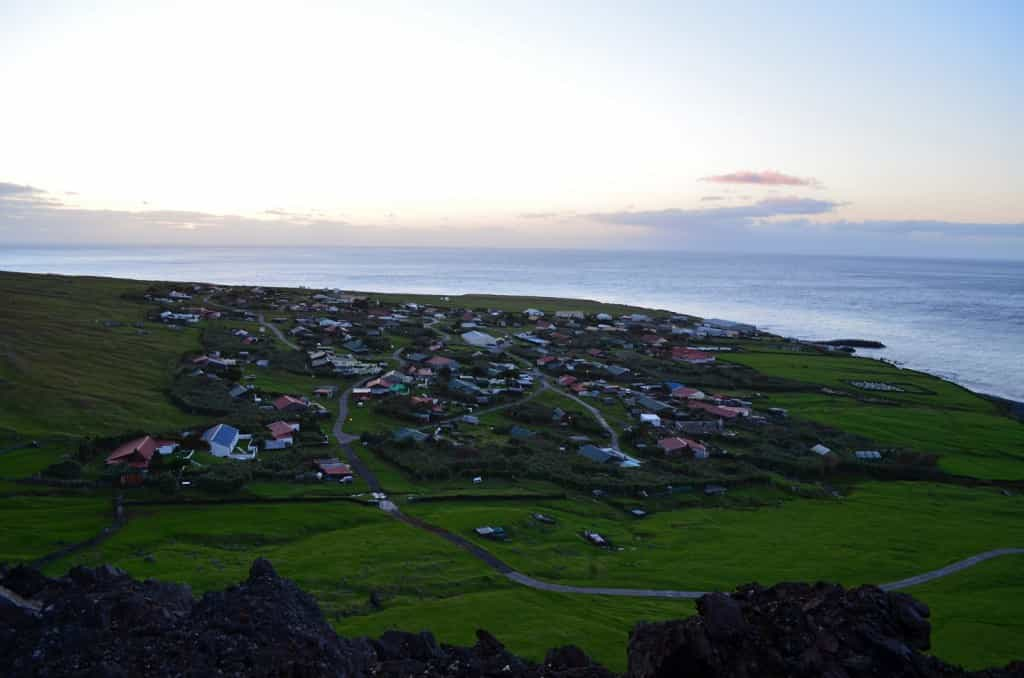





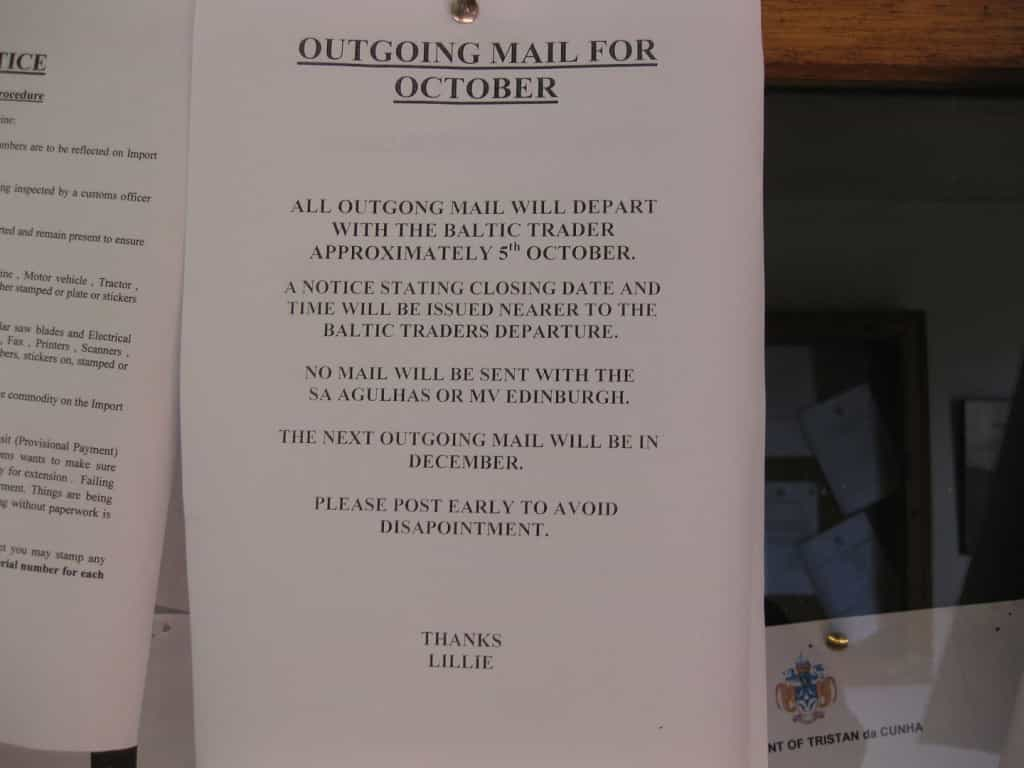
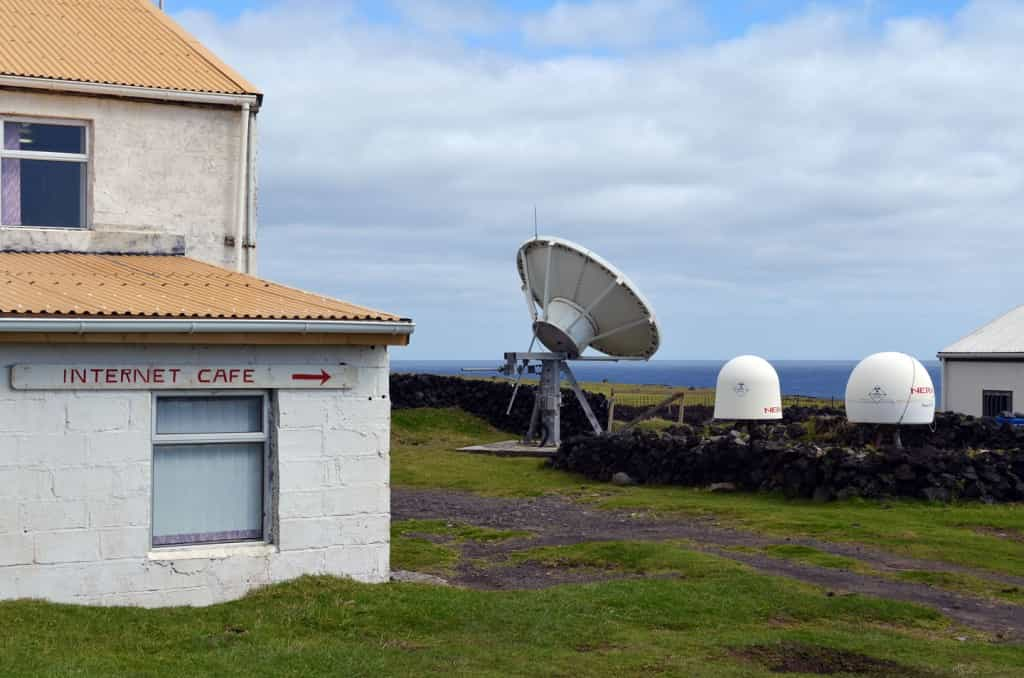




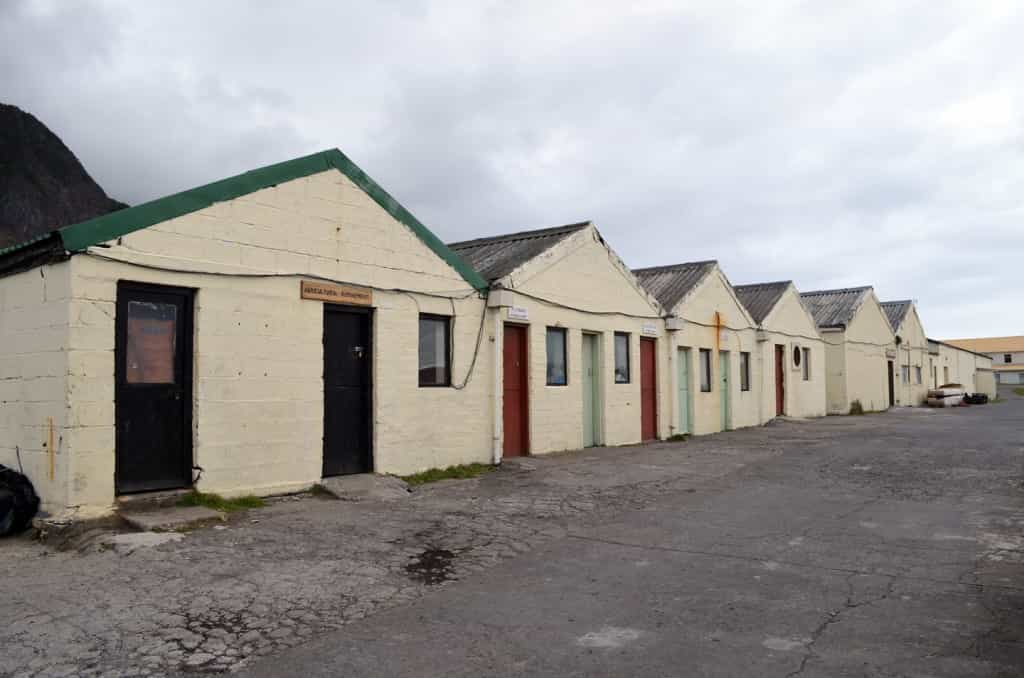





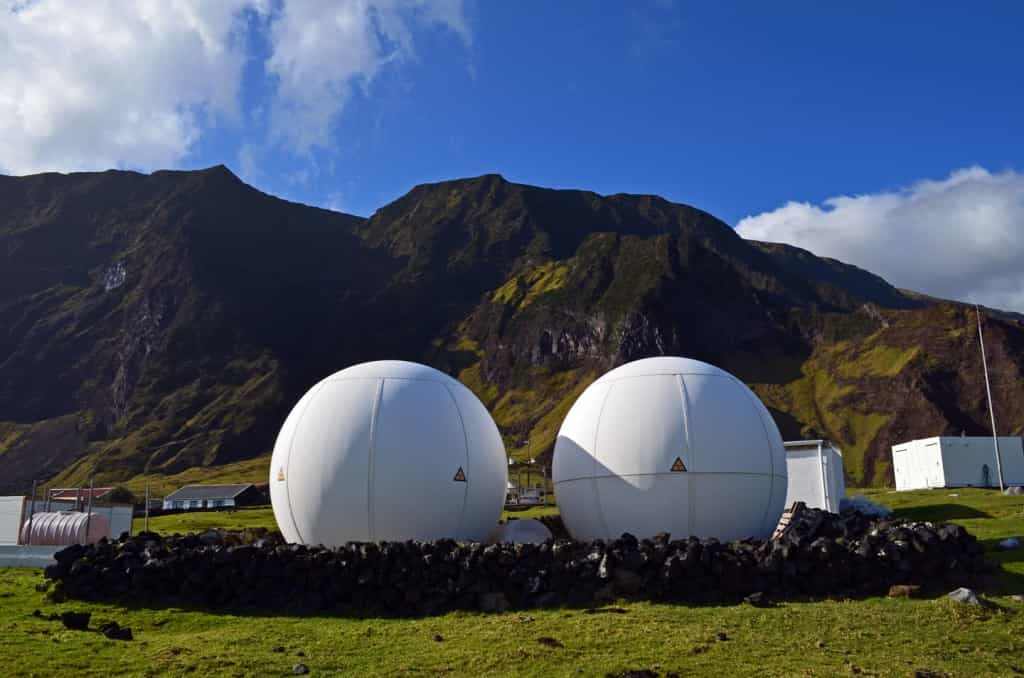



Pingback: Tibet, part 2: Incredible mountains, hot guides and weird fireworks. | Colin’s Notes
Re: Your comment, “This is part of a monitoring station of the UN’s Comprehensive Test Ban Treaty Organization. It conducts seismological, hydroacoustic and airborne radionucleotide monitoring to detect any signs of nuclear explosions around the World”.
Nope ! I am pretty sure that should have said “radionuclide” monitoring-i.e. watching for unusual isotopes that would be the signatures of certain kinds of nuclear weapon activities. Radionucleotides would be man-made,radioactively labeled genetic material components.
It’s a common mistake, but still a mistake.
Very interesting travel report. I just talked to ZD7FT on St. Helena this afternoon using my ham radio station W5NNV and afterwards did some Internet surfing; that’s how I came across your report. I have been a ham radio operator for 57 years and this was my first contact with St. Helena ! It was like talking to somebody sitting right across the table from you. Very exciting.
Thanks Doc! A little embarrassing, considering I have a degree in Molecular Biology. Probably why I had the term radionucleotide in mind when I wrote this! Correction made and good luck talking to TdC in the future.